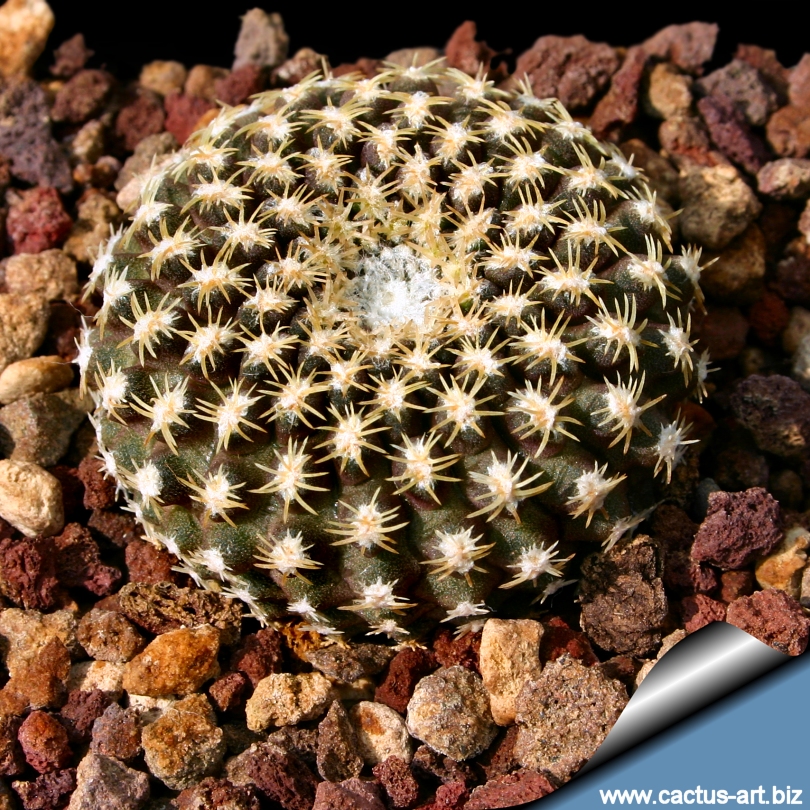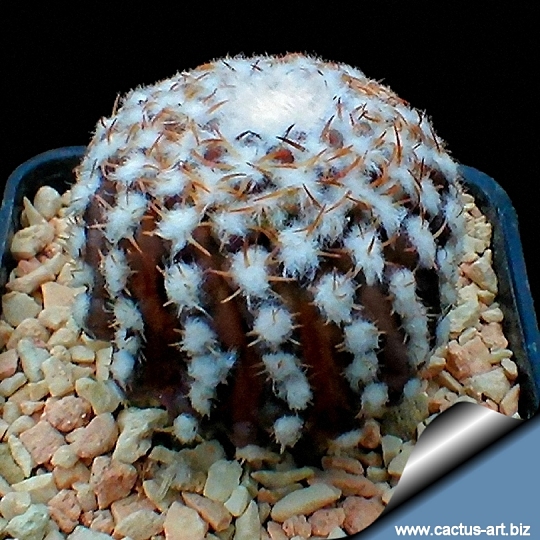|
|

Eriosyce odieri
It is a small reddish-brown cactus with bright white woolly areoles and
(usually) short yellow spines.
|
|
Description: It is a
greyish-green
geophytic cactus that grow flat to the soil or often in
time of drought, shrunken back into the ground . Often it acquires a
reddish, purplish, brownish or almost blue-black colour due to sun
exposure.
Stem: 3-5 cm in diameter, subglobular (flattened in the upper
part) often spineless when old.
Ribs: 18-21 almost indistinguishable and tuberculate with the
podaria arranged in helical lines.
Mamilleae 4-6 mm in diameter.
Areoles: Sunken
Radial spines: 6-12 approx 2-5mm long, spreading,
flattened against the
tubercles and
pectinate, and not intertwining with those of the other areoles,
yellowish, white or pale coffee coloured.
Central spine: Usually absent or 1 short.
Root: Massive tap root.
Flowers: Funnel form at the plant apex, that open during the
hours of sun,
pericarpel with small scales and wool, floral tube with
abundant bristles, tepals pale coloured (whitish, yellow, pinkish or
orangish)
Blooming season: It starts flowering when the stem reach 2 to 6
cm in diameter.
Fruit: Covered with rigid bristles in the upper portion.
Dispersed by wind.
Remarks:
There are several subspecies,
variety and forms of this variable taxon, that differentiates for
size, number of branches, number of tubercles, number and colour of the
spines and for the size and colour of flowers:
Eriosyce odieri ssp. odieri
Eriosyce odieri ssp. krausii
Eriosyce odieri ssp. malleolata (var. malleolata y var. weisseri)
Eriosyce odieri ssp. glabrescens
Eriosyce odieri ssp. fulva
Eriosyce odiery var. monteamargensis Has longer and stouter
spines and a central spine.
Cultivation: The eriosyces
have a thick
taproot and are
susceptible
to
over-watering.
Sometimes they are
grafted to avoid
root
rot problems. Suited for
sunny-bright exposure;
they can
tolerate
light shade.
They like warmth
(recommended minimum winter temperature 5° C). But plant kept perfectly dry can easily
survive
in winter night temperatures
below 0° C (In our greenhouse there was no damage
at -10° C for a few hours in
the winter
of 2002-2003 )
They prefer
airy exposures. They also need a deep pot and good
drainage, to accommodate its
tap root. Keep dry in
winter.
Pests &
diseases: E.
napina is especially
prone to rot, therefore,
underpot in a
smaller container filled with a very
porous compost.
Propagation: Seeds or
graft. Seeds can be sown in the spring or summer. The seedlings
should not be disturbed until they are well rooted, after which
they can be planted separately in small pots.


|
|
Advertising
|
|
|
|
|
Scientific Name:
Eriosyce odieri
(Lem.ex Salm-Dyck)
F. Kattermann
(Cactac.) gen. revis.
& ampl. (Succ. Pl. Res., 1): 118 (1994).
Basionym:
Echinocactus odieri Lem. ex Salm-Dyck 1850
Conservation status: Listed in
CITES Appendix II
Origin:
Endemic to a smal area ranging
from Caleta Cifuncho (25°39’S-70°36’O), Antofagasta region, to the
Copiapó Valley (27°15’S-70°55’O), Atacama. Region.
The variety odieri is only found in the habitat of Morro
Copiapo (27° 9'S - 70°56'O) an solitary mountain alongside the sea 10 km
south of Caldera.
The variety monteamargensis is found in the environment of
Monte Amargo (27°21'S - 70°43'O) the old train station, 30 km sud-east
of Caldera.
It is possible to find very
different plant named "odieri". This plant is very root prone, needs good drainage.
Habitat: Big valley
and gully from 10 to 320 m of altitude, it grows on low costal
flats and slopes in stony and very draining soil in areas where very
little else grows. It's a very drought tolerant species. Despite the
lack of rain where it lives, the extreme aridity is
attenuated by the frequent, often dense, coastal fogs. The fog tends to
concentrate in the form of a cloud band
It shows a recurrent pattern; usually it
is overcast in the early
mornings, the clouds dissipating during the late morning and returning
during the late afternoons.
Synonyms:
- Neoporteria odieri
(Lemaire) Backeberg, 1935
-
Echinocactus
odieri
Lem. ex Salm-Dyck 1849
-
Neochilenia odieri
(Lem. ex Salm-Dyck) Backeb.
1942
-
Chilenia odieri (Lem.
ex Salm-Dyck) Backeb. 1939,
-
Chileorebutia odieri (Lem. ex Salm-Dyck) F.Ritter
1959
-
Thelocephala odieri
(Lem. ex Salm-Dyck) F.Ritter 1980
Other names (Heterotypic
synonyms):
Neochilenia atra, Neochilenia
carneoflora, Neoporteria reichei fa. carneoflora,
Echinocactus reichei ,
Neoporteria reichei ,
Neochilenia reichei, Chilenia reichei, Hildmannia reichei,
Malacocarpus reichei ,
Chilenia reichei ,
Notocactus reichei ,
Thelocephala reichei, Neochilenia pseudoreichei, Neoporteria reichei fa. Pseudoreichei
|
|
|
|

This plant is very nice with
candid woolly areoles and short orange spines, the body colour is dark
brownish-red It likes full sun to light shade .

|
|